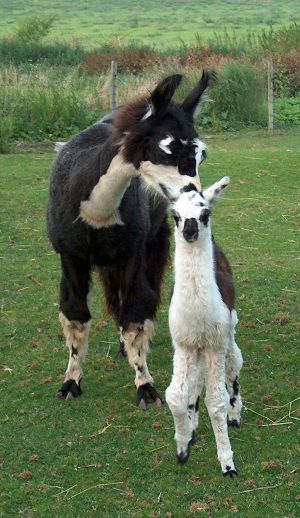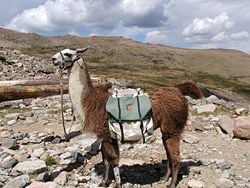Llama
- For other uses, see Llama (disambiguation).
- Not to be confused with Lama.
| Llama | ||||||||||||||
|---|---|---|---|---|---|---|---|---|---|---|---|---|---|---|
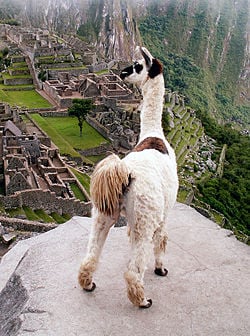 A llama overlooking Machu Picchu, Peru
| ||||||||||||||
|
Domesticated
| ||||||||||||||
| Scientific classification | ||||||||||||||
| ||||||||||||||
| Lama glama (Linnaeus, 1758) |
The llama (Lama glama) is a South American camelid, widely used as a pack animal by the Incas[1] and other natives of the Andes mountains. In South America llamas are still used as beasts of burden, as well as for the production of fiber and meat.[2]
The height of a full-grown, full-size llama is between 5.5 feet (1.6 meters) to 6 feet (1.8 m) tall at the top of the head. They can weigh between approximately 280 pounds (127 kilograms) and 450 pounds (204 kilograms). At birth, a baby llama (called a cria) can weigh between 20 pounds (9 kilograms) to 30 pounds (14 kilograms). Llamas are very social animals and like to live with other llamas as a herd. Overall, the fiber produced by a llama is very soft and is naturally lanolin free. Llamas are intelligent and can learn simple tasks after a few repetitions. When using a pack, llamas can carry about 25%–30% of their body weight for several miles.[3]
Llamas appear to have originated from the central plains of North America about 40 million years ago. They migrated to South America and Asia about 3 million years ago. By the end of the last ice age (10,000–12,000 years ago) camelids were extinct in North America.[3] As of 2007, there were over 7 million llamas and alpacas in South America and, due to importation from South America in the late 20th century, there are now over 100,000 llamas and 6,500–7,000 alpacas in the US and Canada.[4]
Classification
Although early writers compared llamas to sheep, their similarity to the camel was very soon recognized. They were included in the genus Camelus in the Systema Naturae of Linnaeus. They were, however, separated by Cuvier in 1800 under the name of llama along with the alpaca and the guanaco. Vicuñas are in genus Vicugna. The animals of the genus Lama are, with the two species of true camels, the sole existing representatives of a very distinct section of the Artiodactyla or even-toed ungulates, called Tylopoda, or "bump-footed," from the peculiar bumps on the soles of their feet, on which they tread. The Tylopoda consists of a single family, the Camelidae, and shares the Artiodactyla taxon with the Suina (pigs), the Tragulina (chevrotains), and the Pecora (ruminants). The Tylopoda have more or less affinity to each of the sister taxa, standing in some respects in a middle position between them, sharing some characteristics from each, but in others showing great special modifications not found in any of the other taxa.
The discoveries of a vast and previously unsuspected extinct fauna of the American continent of the Tertiary period, as interpreted by the palaeontologists Leidy, Cope, and Marsh, has thrown a flood of light upon the early history of this family, and upon its relations to other mammals. It is now known that llamas at one time were not confined to the part of the continent south of the Isthmus of Panama, as at the present day, since abundant llama-like remains have been found in Pleistocene deposits in the Rocky Mountains and in Central America. Some of the fossil llamas were much larger than current llamas. Some species remained North America during the last ice ages. North American llamas are categorized as a single extinct genus, Hemiauchenia. 25,000 years ago, llama-like animals would have been a common sight in modern-day California, Texas, New Mexico, Utah, Missouri, and Florida.
There are few groups of mammals for which the palaeontological history has been so satisfactorily demonstrated as the llama. Many camel-like animals exhibiting different genetic modifications and a gradual series of changes, coinciding with the antiquity of the deposits in which they are found, have been traced from the thoroughly differentiated species of the modern epoch down through the Pliocene to the early Miocene beds. Their characteristics became more general, and they lost those that especially distinguished them as Camelidae; hence they were classified as forms of the common ancestral Artiodactyl taxon.
No fossils of these earlier forms have been found in the Old World, leading to the hypothesis that the Americas were the original home of the Tylopoda, and that Old World camels migrated into the Old World from the Americas over the Bering land bridge. Gradually driven southward, perhaps by changes of climate, and having become isolated, they have undergone further special modifications. Meanwhile, those members of the family that remained in their original birthplace have become, through causes not clearly understood, restricted solely to the southern or most distant part of the continent.
Characteristics
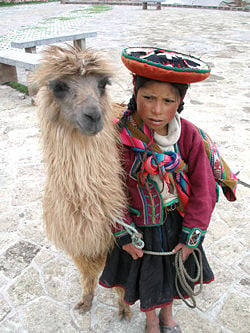
The following characteristics apply especially to llamas. Dentition of adults:-incisors 1/3 canines 1/1, premolars 2/2, molars 3/2; total 32. In the upper jaw there is a compressed, sharp, pointed laniariform incisor near the hinder edge of the premaxilla, followed in the male at least by a moderate-sized, pointed, curved spank canine in the anterior part of the maxilla. The isolated canine-like premolar which follows in the camels is not present. The teeth of the molar series which are in contact with each other consist of two very small premolars (the first almost rudimentary) and three broad molars, constructed generally like those of Camelus. In the lower jaw, the three incisors are long, spatulate, and procumbent; the outer ones are the smallest. Next to these is a curved, suberect canine, followed after an interval by an isolated minute and often deciduous simple conical premolar; then a contiguous series of one premolar and three molars, which differ from those of Camelus in having a small accessory column at the anterior outer edge.
The skull generally resembles that of Camelus, the relatively larger brain-cavity and orbits and less developed cranial ridges being due to its smaller size. The nasal bones are shorter and broader, and are joined by the premaxilla.
- cervical 7,
- dorsal 12,
- lumbar 7,
- sacral 4,
- caudal 15 to 20.
The ears are rather long and slightly curved inward, characteristically known as "banana" shaped. There is no dorsal hump. Feet are narrow, the toes being more separated than in the camels, each having a distinct plantar pad. The tail is short, and fibre is long, woolly and soft.
In essential structural characteristics, as well as in general appearance and habits, all the animals of this genus very closely resemble each other, so that whether they should be considered as belonging to one, two, or more species is a matter of controversy among naturalists.
The question is complicated by the circumstance of the great majority of individuals which have come under observation being either in a completely or partially domesticated state. Many are also descended from ancestors which have previously been domesticated; a state which tends to produce a certain amount of variation from the original type. It has, however, lost much of its importance since the doctrine of the distinct origin of species has been generally abandoned. The four forms commonly distinguished by the inhabitants of South America are recognized by some naturalists as distinct species, and have had specific designations attached to them, though usually with expressions of doubt, and with great difficulties in defining their distinctive characteristics.
These are:
- the llama, Auchenia glama (Linn.), or Lama peruana (Tiedemann);
- the alpaca, A. pacos (Linn.);
- the guanaco or huanaco, A. huonaeus (Molina); and
- the vicuña, A. vicugna (Molina), or A. vicuiena, (Cuv.).
The llama and alpaca are only known in the domestic state, and are variable in size and of many colors, being often white, brown, or piebald. Some are grey or black. The guanaco and vicuña are wild, the former being endangered, and of a nearly uniform light-brown color, passing into white below. They certainly differ from each other, the vicuña being smaller, more slender in its proportions, and having a shorter head than the guanaco. The vicuña lives in herds on the bleak and elevated parts of the mountain range bordering the region of perpetual snow, amidst rocks and precipices, occurring in various suitable localities throughout Peru, in the southern part of Ecuador, and as far south as the middle of Bolivia. Its manners very much resemble those of the chamois of the European Alps; it is as vigilant, wild, and timid. The fiber is extremely delicate and soft, and highly valued for the purposes of weaving, but the quantity which each animal produces is minimal. Alpaca are descended from a wild vicuna ancestor while the domesticated llama is descended from a wild guanaco ancestor, though at this point there has been a considerable amount of hybridization between the two species.
Differentiating characteristics between llamas and alpacas include the llama's larger size and longer head. Alpaca fiber is generally more expensive but not always more valuable. Alpacas tend to have a more consistent color throughout the body. The most apparent visual difference between llamas and camels is that camels have a hump or humps and llamas do not.
Commonly unknown, llamas do not have eyelashes. However, their cousin the alpaca does.
Reproduction
Llamas have an unusual reproductive cycle for a large animal. Female llamas are induced ovulators. Through the act of mating, the female releases an egg and is often fertilized on the first attempt. Female llamas do not go into "heat" or have an estrus cycle.[5]
Like humans, llama males and females mature sexually at different rates. Females reach puberty at approximately 12 months. However, males do not become sexually mature until approximately 3 years.[6]
Mating
Llamas mate with the female in a kush (lying down) position, which is fairly unusual in a large animal. They mate for an extended period of time (20–45 minutes), also unusual in a large animal.
Gestation
The gestation period of a llama is 11 1/2 months (350 days). Dams (female llamas) do not lick off their babies, as they have an attached tongue which does not reach outside of the mouth more than half an inch. Rather, they will nuzzle and hum to their newborns.[7]
Breeding situations
Harem breeding
Male is left with females most of the year.
Field breeding
A female is turned out into a field with a male llama and left there for some period of time. This is the easiest method in terms of labor, but the least useful in terms of prediction of a likely birth date. An ultrasound test can be performed and together with the exposure dates a better idea when the cria is expected can be determined.
Hand breeding
This is the most efficient method, but requires the most work on the part of the human involved. A male and female llama are put into the same pen and breeding is monitored. They are then separated and rebred every other day until one or the other refuses the breeding. Usually one can get in two breedings using this method, though some studs have routinely refused to breed a female more than once. The separation presumably helps to keep the sperm count high for each breeding and also helps to keep the condition of the female llama's reproductive tract more sound. If the breeding is not successful within two to three weeks, the female is rebred once again.
Pregnancy
Testing for pregnancy
Llamas should be tested for pregnancy after breeding at 2–3 weeks, 6 weeks, and at least 12 weeks.
- "Spit testing". Bring the potentially pregnant dam to an intact male. If the stud attempts to breed her and she lies down for him within a fairly short period of time, she is not pregnant. If she remains on her feet, spits, attacks him, or otherwise prevents his being able to mate, it is assumed that she is probably pregnant. This test gets its name due to the dam spitting at the male if she is pregnant.
- Progesterone testing. A veterinarian can take a blood sample test for progesterone. A high level can indicate a pregnancy.
- Palpation. In this test, the veterinarian or breeder manually feels inside the llama to detect a pregnancy. There are some risks to the llama, but it can be an accurate method for pregnancy detection.
- Ultrasound is the most accurate method in the hands of an experienced veterinarian. A veterinarian experienced with ultrasound can do an exterior exam and detect a fetus as early as 45 days.
Pros and cons of pregnancy testing
Spit testing with an intact male is generally free and is usually accurate. However, some hormonal conditions in females can make them reject a male when they are in fact not pregnant, and, more rarely, accept a male when they are pregnant. Progesterone tests can give a high reading in some females with a hormonal problem who are in fact not pregnant. Neither of the previous methods, nor palpation, can give you a reasonably accurate idea of the age of the fetus, while an ultrasound procedure can. In addition, an ultrasound procedure can distinguish between pregnancy and misleading physical conditions, or between a live and dead fetus. The big disadvantage of an ultrasound procedure is that some training in the use of ultrasound equipment is required, and not all veterinarians have the equipment needed to perform the examination.
Nutrition
Options for feeding llamas are quite wide. The llama owner has a wide variety of commercial and farm based food products to choose from for llamas. The major determining factors which enter into the decision of what to feed include feed cost, availability of feed, nutrient balance and energy density required. Young llamas, which are still actively growing, require a greater concentration of nutrients than mature animals because of their relatively smaller digestive tract capacity.[8]
| Body Weight (lbs) |
Bromgrass | Alfalfa | Corn Silage | |||
|---|---|---|---|---|---|---|
| (as fed) | (dry matter) | (as fed) | (dry matter) | (as fed) | (dry matter) | |
| 22 | 0.8 | 0.7 | 0.5 | 0.5 | 1.5 | 0.4 |
| 44 | 1.3 | 1.1 | 0.9 | 0.8 | 2.6 | 0.7 |
| 88 | 2.1 | 1.9 | 1.5 | 1.3 | 4.3 | 1.2 |
| 110 | 2.6 | 2.3 | 1.7 | 1.6 | 5.2 | 1.4 |
| 165 | 3.4 | 3.1 | 2.3 | 2.1 | 6.9 | 1.9 |
| 275 | 5.0 | 4.5 | 3.4 | 3.1 | 10.1 | 2.8 |
| 385 | 6.4 | 5.7 | 4.3 | 3.9 | 12.9 | 3.6 |
| 495 | 7.8 | 7.0 | 5.3 | 4.8 | 15.8 | 4.4 |
| 550 | 8.5 | 7.6 | 5.7 | 5.2 | 17.0 | 4.8 |
Behavior
Llamas which are well-socialized and trained to halter and lead after weaning are very friendly and pleasant to be around. They are extremely curious and most will approach people easily. However, llamas who are bottle-fed or over-socialised and over-handled as youngsters will become extremely difficult to handle when mature, when they will begin to treat humans as they treat each other, which is characterized by bouts of spitting, kicking and neck wrestling. Anyone having to bottle-feed a cria should keep contact to a minimum and stop as soon as possible.
When correctly reared spitting at a human is a rare thing. Llamas are very social herd animals, however, and do sometimes spit at each other as a way of disciplining lower-ranked llamas in the herd. A llama's social rank in a herd is never static. They can always move up or down in the social ladder by picking small fights. This is usually done between males to see who becomes alpha. Their fights are visually dramatic with spitting, ramming each other with their chests, neck wrestling and kicking, mainly to knock the other off balance. The females are usually only seen spitting as a means of controlling other herd members.
While the social structure might always be changing, they live as a family and they do take care of each other. If one notices a strange noise or feels threatened, a warning bray is sent out and all others come to alert. They will often hum to each other as a form of communication.
The sound of the llama making groaning noises or going "mwa" is often a sign of fear or anger. If a llama is agitated, it will lay its ears back. One may determine how agitated the llama is by the materials in the spit. The more irritated the llama is, the further back into each of the three stomach compartments it will try to draw materials from for its spit.
An "orgle" is the mating sound of a llama or alpaca, made by the sexually aroused male. The sound is reminiscent of gargling, but with a more forceful, buzzing edge. Males begin the sound when they become aroused and continue throughout the act of procreation — from 15 minutes to more than an hour.[10] [11]
History
One of the main uses for llamas at the time of the Spanish conquest was to bring down ore from the mines in the mountains.[12] Gregory de Bolivar estimated that in his day, as many as three hundred thousand were employed in the transport of produce from the Potosí mines alone, but since the introduction of horses, mules, and donkeys, the importance of the llama as a beast of burden has greatly diminished.[13]
The Inca deity Urcuchillay was depicted in the form of a multicolored llama.[14] The Moche people frequently placed llamas and llama parts in the burials of important people, as offerings or provisions for the afterlife.[15] The Moche culture of pre-Columbian Peru depicted llamas quite realistically in their ceramics.
Llama fiber
Llamas also have a fine undercoat which can be used for handicrafts and garments. The coarser outer guard hair is used for rugs, wall-hangings and lead ropes. The fiber comes in many different colors ranging from white, grey, redish brown, brown, dark brown and black.
The individual shafts of the wool can be measured in micrometres. 1 micrometre = 1/1000 millimeter.
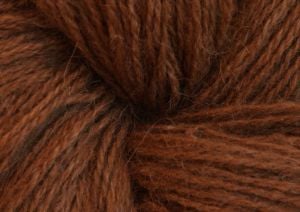
| Animal | Fiber diameter (micrometres) |
|---|---|
| Vicuña | 6 – 10 |
| Alpaca (Suri) | 10 - 15 |
| Muskox (Qivlut) | 11 - 13 |
| Merino | 12 - 20 |
| Angora Rabbit | 13 |
| Cashmere | 15 - 19 |
| Yak Down | 15 - 19 |
| Camel Down | 16 - 25 |
| Guanaco | 16 - 18 |
| Llama (Tapada) | 20 - 30 |
| Chinchilla | 21 |
| Mohair | 25 - 45 |
| Alpaca (Huacaya) | 27.7 |
| Llama (Ccara) | 30 - 40 |
Technically the fiber is not wool as it is hollow with a structure of diagonal 'walls' which makes it strong, light and good insulation. Wool as a word by itself refers to sheep fiber. However, llama fiber is commonly referred to as llama wool or llama fiber.
In popular culture
The name "llama" has been used for a wide variety of descriptions for people and items alike within general computing and gaming industries. Within some computing environments, the label "llama" has been derogatory indicating a person with little knowledge and new to the environment. Acronyms have been spelled similarly to llama and thus pronounced as llama. The llama has proved to be quite popular among some simulation games. Also the llama has been made popular in many movies as well, such as Napoleon Dynamite and the Disney film The Emperor's New Groove.
ReferencesISBN links support NWE through referral fees
This article originally incorporated text from the Encyclopædia Britannica Eleventh Edition, a publication now in the public domain.
- ↑ Little Llamas. Inca culture (2006-10-10).
- ↑ Information Resources on the South American Camelids: Llamas, Alpacas, Guanacos, and Vicunas 1943-2006 (2007-06-25).
- ↑ 3.0 3.1 Llama (2007-06-25).
- ↑ South Central Llama Association (2007-06-25). Llama Facts.
- ↑ Greta Stamberg and Derek Wilson (2007-04-12). Induced Ovulation. Llamapaedia.
- ↑ L. W. Johnson (2007-04-17). Llama reproduction. College of Veterinary Medicine and Biomedical Sciences, Colorado State University, Fort Collins.. National Library of Medicine and the National Institutes of Health.
- ↑ The llama reproductive cycle. LlamaWeb (2007-04-17).
- ↑ Randy Sell (2007-04-17). Llama. Department of Agricultural Economics, North Dakota State University.
- ↑ Murray E. Fowler, DVM (1989). "Medicine and Surgery of South American Camelids; Llama, Alpaca, Vicuña, Guanaco". Iowa State University Press.
- ↑ Greta Stamberg and Derek Wilson (1997-09-02). Behavior: Sounds. Llamapedia.
- ↑ Brian and Jane Pinkerton (2008-05-17). Llama Sounds. Humm Page.
- ↑ Jared Diamond (2007-04-12). Guns, Germs & Steel. The Show: Episode Two. PBS.
- ↑ Jared Diamond (2007-04-12). Guns, Germs & Steel. The story of ... Llamas. PBS.
- ↑ D'Altroy, Terence N. [2002]. "The Inca Pantheon", The Incas, The Peoples of America. Oxford: Blackwell Publishing, 149. ISBN 9780631176770.
- ↑ Berrin, Katherine & Larco Museum. The Spirit of Ancient Peru:Treasures from the Museo Arqueológico Rafael Larco Herrera. New York: Thames and Hudson, 1997.
- ↑ Beula Williams (2007-04-17). Llama Fiber. International Llama Association.
- Integrated Taxonomic Information System (ITIS). 2004. Lama G. Cuvier, 1800 ITIS Taxonomic Serial No.: 624943. Retrieved October 2, 2008.
- Portman, C. and P. Myers. 2004. "Lama glama" (On-line), Animal Diversity Web. Accessed October 02, 2008 at http://animaldiversity.ummz.umich.edu/site/accounts/information/Lama_glama.html.
External links
- Queso Cabeza Farm Llama Info - Llama information page. Commercial site but information is comprehensive and useful
- Llamas: From the Andes to the Rockies - Llama information page.
- Llamapaedia Orgle Sound (AIFF).
- Lama Jounral - Llama & Alpaca Social Network. Meet people with interests in llamas and alpacas.
| ||||||||||
Credits
New World Encyclopedia writers and editors rewrote and completed the Wikipedia article in accordance with New World Encyclopedia standards. This article abides by terms of the Creative Commons CC-by-sa 3.0 License (CC-by-sa), which may be used and disseminated with proper attribution. Credit is due under the terms of this license that can reference both the New World Encyclopedia contributors and the selfless volunteer contributors of the Wikimedia Foundation. To cite this article click here for a list of acceptable citing formats.The history of earlier contributions by wikipedians is accessible to researchers here:
The history of this article since it was imported to New World Encyclopedia:
Note: Some restrictions may apply to use of individual images which are separately licensed.
